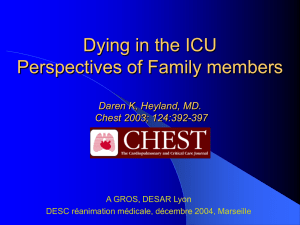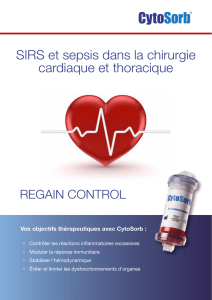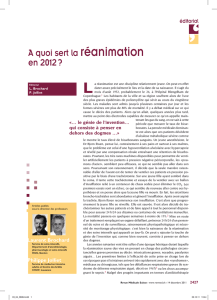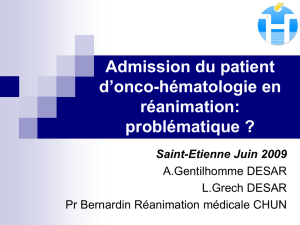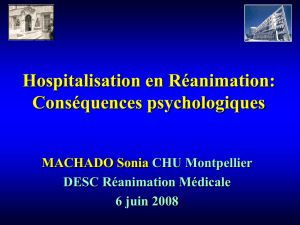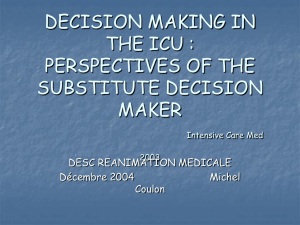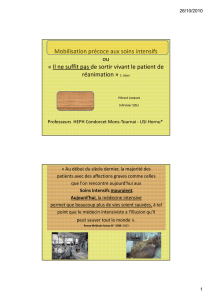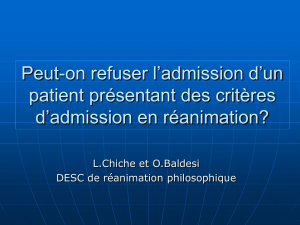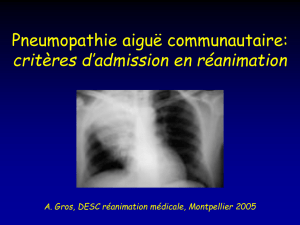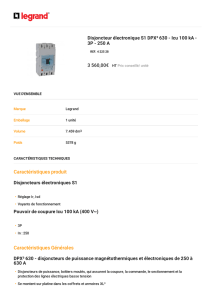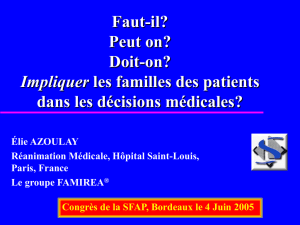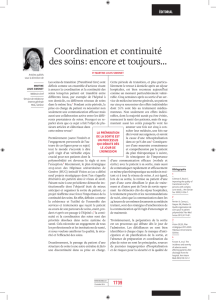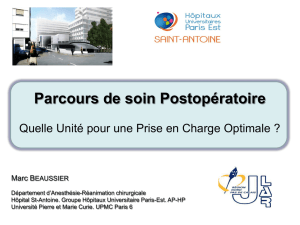Insuffisance respiratoire aiguë chez le patient onco
publicité
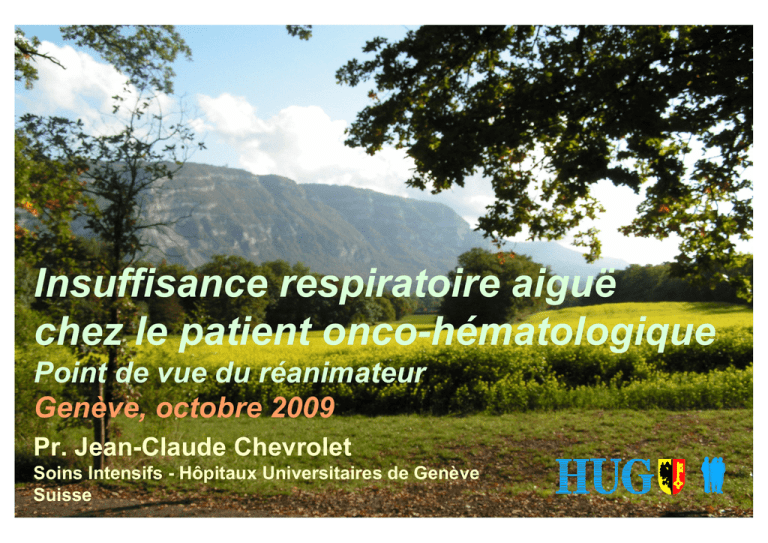
Insuffisance respiratoire aiguë chez le patient onco-hématologique Point de vue du réanimateur Genève, octobre 2009 Pr. Jean-Claude Chevrolet Soins Intensifs - Hôpitaux Universitaires de Genève Suisse Ce que j’aimerais savoir du réanimateur … Admission en réanimation de mon patient onco-hématologique : .quand ? pourquoi ? .si mon patient est âgé, cela change-t-il quelque chose ? .les refus d’admission en réanimation Que va devenir mon patient en réanimation ? .risque de décès ? .vont-ils “arrêter les machines” ? .la “réanimation d’attente “ ? “Just say no” Carlon GC Crit Care Med 1989;17:106 “Consider saying yes” Groeger J Crit Care Med 2003;31;123 Today ? … say yes … but for a limited amount of time ! Probability of survival after discontinuation of mechanical ventilation - bone marrow transplants post ICU percent survival rate 30 25 ICU survival 26 % 20 15 hospital discharge : 4 % 6-months survival > tx : 3 % 10 5 0 0 1 2 3 4 5 6 7 8 9 10 11 12 months Crawford S, Am Rev Respir Dis 1988 Unajusted mortality rate in critically ill cancer patients by year of study publication 100 >>90 90% % mortality rate, % 80 <<40 40% % 60 40 20 0 1983 1986 1991 1998 2001 2004 2008 study publication, year Darmon M et al, Curr Opin Oncol 2009;21:318 Unadjusted mortality rate in critically ill bone marrow transplants patients by year of study publication 100 >>95 95% % mortality rate, % 80 <<50 50% % 60 40 20 0 1989 1983 1995 1997 1999 2001 2003 2006 2009 study publication, year Darmon M et al, Curr Opin Oncol 2009;21:318 Improving survival in critically ill multiple myeloma patients 100 survival rate, % 80 60 > 60 % 2001 - 2006 40 > 45 % 1997 - 2000 20 < 20 % 1990 - 1996 0 P (Log Rank) = 0.001 0 10 20 30 40 50 60 days after admission Peigne V et al , Intensive Care Med 2009;35:512 To be honest A pessimistic view … Biases ? improvement of survival caused by restrictive policy : expertise may have increased selection of patients for ICU admission recent studies performed in a small number of groups with an extensive experience most studies report hospital mortality rates : .what about QOL ? what about mean/long term ? Qui est à l’origine de ces résultats encourageants ? Vous ? Nous ? Recent advances (some) in the treatment of neoplastic disorders GM-CSF and neutropenias intensified treatments for acute leukemias (transplants) Imatinib (Gleevec®) for chronic myeloid leukemia Rituximab (anti-CD20) for B-cell lymphomas all-trans retinoic acid/As2O3 for promyelocytic leukemias impact of cytogenetics … etc … VOUS ! Recent advances in ICU management non-invasive mechanical ventilation (NIV) protective lung strategy in ARDS adjunctive therapy of septic shock (corticosteroids, activated protein-C, …) better management of sedation and ventilator weaning less invasive diagnostic techniques less invasive monitoring techniques … etc … NOUS ! Non-invasive mechanical ventilation on the prognosis of cancer patients submitted to mechanical ventilation 237 patients, solid and haematological cancer 1990 - 1995 1996 - 1998 132 105 Ø pt NIMV 20 % with NIMV mortality rate after matching 71 % 44 % (p < 0.001) Azoulay E et al, Crit Care Med 2001 Noninvasive mechanical ventilation in immunosuppressed patients with respiratory failure parameter (%) control (n = 26) NIV group (n = 26) p 46 38 50 0.03 0.03 0.02 control NIV group p 81 % 67 50 53 % 44 50 0.02 0.37 0.83 endotracheal intubation 77 ICU death 69 hospital death 81 Problems onco-hematology patients ttt related immunosuppression HIV patients Hilbert G et al, NEJM 2001;344:481 NIMV in patients with malignancies and acute respiratory failure - a still pending question invasive (intubation) mechanical ventilation intubation too early - risks of intubation (VAPa) Hilbert G et al, NEJM 2001 intubation too late - risk of untreatable ARDSb Depuydt P et al, J Crit Care 2009 aVAP : ventilator associated pneumonia bARDS : acute respiratory distress syndrome Non-invasive ventilation in acute respiratory failure - a meta-analysis 405 patients, 15 RCT trials COPD patients reduction in mortality rate reduction in intubation rate reduction in hospital LOS -8% - 19 % - 3.7 days p = 0.03 p = 0.001 p = 0.004 0% -2% 0 day p = NS p = NS p = NS non COPD patients reduction in mortality rate reduction in intubation rate reduction in hospital LOS* *LOS : length of stay Peter JV, Crit Care Med 2002; 530:555 Non-invasive mechanical ventilation to prevent intubation in AECOPDa too ill pH-defined pH-defined pH < 7.10 (7.20 ?) pH > 7.35 severe ARF mild ARF ≈ 70 % of patients excluded Bott 1993 Brochard 1995 Kramer 1995 Wysocki 1995 not ill enough NIV no benefit of NIV Barbe 1996 Keenan 2005 aacute exacerbation of COPD A chart of failure risk for non-invasive ventilation in AECOPDa 100 - 75 % 74 - 50 % 49 - 25 % 24 - 0 % percentage of patients who fail NIV aacute exacerbation of COPD Confalonieri et al. Eur Respir J 2005; 25:348-355 Predictors of NIV failure in patients with hematologic malignancy and acute respiratory failure failure rate for NIV : 54 % mortality rate when failure vs. success : 79 vs. 41 % multivariate analysis - n = 99 parameter OR RR under NIV > 30 min-1 1.2 delay from ICU to NIV 2.0 need for vasopressors 6.5 need for dialysis 18.3 ARDS at time of NIV 77.7 95% CI 1.05-1.33 1.02-3.94 1.59-26.53 1.99-168.7 6.88-873.1 p 0.005 0.04 0.009 0.01 0.004 Adda M et al, Crit Care Med 2008;36:2766 Peak inspiratory pressure 45 cmH22O 20 20 min min 5 min To Dreyfuss D et al, Am Rev Respir Dis 1985;132:880 VILI - atelectotrauma and volotrauma overdistension opening-closing alveolar cycles VVTT in in this this zone zone «« volotrauma volotrauma »» VVTT in in this this zone zone «« atelectotrauma atelectotrauma »» Gattinoni L et al. Curr Opin Crit Care 2005 VILI - atelectotrauma and volotrauma overdistension “open “open the theVVTTlung, lung, in in this this zone zone «« volotrauma volotrauma »» keep keep it it open, open, VVTT in in this this zone zone and gently” atelectotrauma and treat treat««it it gently”»» atelectotrauma opening-closing alveolar cycles Gattinoni L et al. Curr Opin Crit Care 2005 Noninvasive mech. ventilation (NIV) in patients with malignancies and acute respiratory failure malignancy and hypoxemic acute respiratory failure palliative care coma, shock copious secretions acute coronary syndrome acute cardiac arrhythmias bleeding, etc. vasopressors ARDS, MODS delayed ARF onset unknown cause of ARF etc. attempt for curative approach contraindication for NIV trial ? NO high risk for NIV failure ? YES NO patient not tolerating NIV respiratory rate > 40 min-1 NIV dependency ≥ 3 days ø clinical and/or ABG improvement > 6 h YES high risk for failure under NIV ? immediate intubation seriously consider intubation YES proceed to intubation Soares M et al, J Crit Care 2009 (in press) Facteurs pronostiques chez les malades onco-hématologiques admis en réanimation modulation de l’admission en réanimation ? Predictive factors of ICU need in patients with haematological malignancies and pneumonia age type of haematological malignancy type of chemotherapy NS thoracic radiologic involvement PaO2 hepatic failure neutropenia bacteremia 0.001 0.0005 0.001 NS NS .Gram-negative 0.01 Gruson D et al, Intensive Care Med 2004;30:965 Independent predictors of hospital mortality Multivariable analysis - multiple myeloma parameters poor chronic health status need for vasopressors need for mechanical ventilation ICU and multiple myeloma .ICU - 1996 to 2001 .ICU - 2002-2006 .ICU less than 2 days after hospital admission OR 2.27 2.57 4.33 2.77 95 % CI 1.04-4.99 1.12-5.86 1.86-10.10 1.13-6.79 p value 0.04 0.02 0.0007 0.02 0.28 0.20 0.41 0.10-0.84 0.06-0.64 0.19-0.89 0.02 0.005 0.02 Peigne V et al , Intensive Care Med 2009;35:512 Predictors of poor ICU-prognosis in critically ill cancer patients selected by onco-hematologists .present response to chemotherapy .stage of malignancy .long term prognosis of malignancy no/weak impact but, biases : .patients selection by onco-hematologists (palliative care) .impact of ICUs treatments on acute survival may mask cancer prognosis Massion P et al : Crit Care Med 2002;30:2260 Darmon M et al : Curr Op Oncol 2009;21:318 Mechanical ventilation in onco-hematologic patients with/without MODSa cumulative survival rate, % 100 only mechanical ventilation 80 60 50 % 40 20 p (Log rank) = 0.04 0 0 aMODS 20 % mechanical ventilation and another organ failure : multiple organ dysfunction syndrome 5 10 15 20 25 30 days from ICU admission RéaMiniMax Study Group, 2009 (St Louis Paris - personal communication) Thirty-days mortality rate according to the number of organ failures Myelo-monocytic leukemia (M5) 100 30-d mortality rate, % 80 60 40 20 0 1 2 3 4 5 6 number of failing organs Darmon M et al, J Clin Oncol 2005;23:1327 La “réanimation illimitée d’attente” dans les maladies onco-hématologiques Daily assessment of organ failure and prognosis in critically ill cancer patients Logistic Organ Dysfuntion Score - LODS 10 8 6 survivors non survivors ** * ** ** ** 4 2 0 * p < 0.05 ** p < 0.01 1 2 3 6 9 12 15 18 days after ICU admission Lecuyer L et al : Crit Care Med 2007;35:808 “Réanimation d’attente” - patients onco-hématologiques ? 40 40% % 20 20% %patients patientssevrés sevrés de detoutes toutesles lessuppléances suppléances d’organe d’organevital vital stop ICU “étage” 10 10% %stabilité stabilitédes des défaillances défaillancesvitales vitales 20 20%* %* 20 20% %amélioration, amélioration,mais mais:: défaillance(s) défaillance(s)persistantes persistantes d’organe(s) d’organe(s)vital(-ux) vital(-ux) 50 50%* %* 10 10% % 40 40% %patients patients décédés décédés 10 10% %aggravation aggravationdes des défaillances défaillancesvitales vitales poursuite ICU limite (jours ?) discussion individuelle *70 *70% %des despts pts::clair clair>>33--55jours jours 30 30% %des despts pts::question questiondemeure demeure 30 30% % stop ICU death Evaluation après 3 à 5 j de “réanimation illimitée” “Réanimation d’attente” - patients onco-hématologiques ? 40 % tous tous les les patients patients avec avec cancer cancer 20 20% %patients patientssevrés sevrés de detoutes toutesles lessuppléances suppléances d’organe d’organevital vital 50 % 10 % 40 40% %patients patients décédés décédés admis admis en en réanimation réanimation 10 10% %stabilité stabilitédes des défaillances défaillancesvitales vitales .intubés .intubés après après JJ33 10 10% %aggravation aggravationdes des défaillances .avec défaillances vitales JJ33 vitales .avec amines pressives des amines pressives débutées stop ICU des débutées après après “étage” .avec 33 J .avec une une dialyse dialyse initiée initiée après après J poursuite ICU limite (jours ?) 20 % amélioration, mais :: 20 % amélioration, mais ………………………………… ……… discussion individuelle ………………………………… ……… défaillance(s) défaillance(s)persistantes persistantes d’organe(s) d’organe(s)vital(-ux) vital(-ux) 30 % stop!!! ICU décèdent décèdent !!! death Lecuyer Lecuyer LL et et al, Crit Care al, Crit Care Med Med 2007;35:808 2007;35:808 70 70% %::clair clair>>33--55jours jours 30 30% %::question questiondemeure demeure Evaluation après 3 à 5 jours de “réanimation illimitée” ICU admission in onco-hematologic patients General recommendations - textbooks before 2008 cancer patients proposed for ICU admission bedridden pts and/or no lifespan-extending treatment ICU not recommended encourage palliative care intermediate situation propose ICU trial if patient/family agreement newly diagnosed malignancy (first treatment line) full code management Azoulay E et al : Intensive Care Med 2006;32:3 Darmon M et al : Curr Op Oncol 2009;21:318 ICU admission in onco-hematologic patients More specific recommendations - 2009 cancer patients proposed for ICU admission evaluate triage criteria by onco- and hematologists aSCT : stem cell transplantation; : graft vs. host disease cHFH : hemophagocytic lymphohistiocytosis ; dATLS : acute tumor lysis syndrome bGVH propose unlimited ICU admission to ensafe invasive procedures .other and doubtful situations .new drugs with proven efficacy .autologous SCTa .allogenous SCTa with controlled GVHDb .bedridden patients .no lifespan-extending treatments .patients > 70 y AND altered performance status .allogenic SCTa with uncontrolled GVHDb .newly diagnosed malignancy .specific organ failure (HLHc, ATLSd, hypercalcemia, etc … ) L’ âge du patient joue-t-il un rôle dans les résultats de la réanimation ? What is an « old » patient ? « A patient who is older than his/her doctor » 70-75 y 80-85 y > 85 y … survival rate, % Post ICU survival - age and severity of disease 1.0 .8 .6 .4 .2 0 1.0 .8 .6 .4 .2 0 APACHE II ≤ 18 APACHE II ≥ 19 65 - 74 year ≥ 75 year 0 3 6 9 12 months Chelluri L, Arch Intern Med 1995;155:1013 Short-term and long-term mortality in very elderly ICU-patients - type of admission survival rate, % 100 planned surgical elective surgical medical 80 60 40 n = 578 20 ≥≥ 80 80 years years 0 0 12 24 36 48 60 72 84 months since admission De Rooij S et al, Intensive Care Med 2006;32:1089 mortality incidence mortality rate, % incidence, per 1000 pop Age-specific incidence and mortality rates for severe sepsis/septic shock Angus D et coll : Crit Care Med 2001;29:1303 Acute lung injury and survival by age 28-day survival % 100 n = 98 n = 160 n = 180 75 n = 149 n = 142 50 n = 130 n = 43 25 0 <29 30-39 40-49 50-59 60-69 70-79 >80 age - years Ely EW, Ann Intern Med 2002;136:25 Limitation / arrêt des thérapeutiques actives en réanimation - LATAréa 1. non-admission en réanimation 2. non-escalade des thérapeutiques - withholding 3. retrait des traitements - withdrawing Medical ICU University Hospital of Geneva Switzerland Data base - deaths 1998 - 2001 year 1998 1999 2000 2001 n patients 1540 1746 1637 1828 n deaths 103 129 100 122 % induced deaths 85 87 89 89 Décès à Genève en 2007 environ 60 % de nos concitoyens décèdent en milieu institutionnel - hôpitaux, établissements médico-sociaux environ un p.mille de nos concitoyens hospitalisés en soins aigus décèdent dans les services de : .soins intensifs 15 % .médecine interne générale 17 .réhabilitation gériatrie 53 .dont soins palliatifs 20 .autres 15 Pius PP XII - Problèmes religieux et moraux de la réanimation - déclaration aux anesthésistes, 1957 « Le devoir de prendre les soins nécessaires pour conserver la vie et la santé (…) n ’oblige qu ’à l ’emploi des moyens ordinaires. (…) L ’interruption des tentatives de réanimation n ’est jamais qu ’indirectement cause de de la cessation de la vie » Joh. Paulus PP II- Evangelium vitae, 1995 « On peut en conscience renoncer à des traitements qui ne procureraient qu ’un sursis précaire et pénible de la vie,sans interrompre pourtant les soins » Facteurs non médicaux liés aux refus d’admission en réanimation facteur OR 95%CI p< effet centre horaire 8-18 h manque de lits 4.9 0.46 4.8 2.9 - 8.4 0.0001 0.28 - 0.75 0.0001 2.9 - 8.1 0.00 Garrouste-Orgeas M, SRLF 2003 cancer âge du patient désir du patient lits réa disponibles personalité du pt 1.1 2.1 4.2 1.9 3.6 0.6 - 2.0 1.1 - 3.8 2.3 - 7.9 1.1 - 3.4 2.1 - 6.3 0.67 0.02 0.01 0.02 0.01 Escher-Imhof M, BMJ 2004 Perspectives Quelques pistes pour avancer … impact de la réanimation sur le pronostic à moyen et à long terme des patients onco-hématologiques en état critique “effet centre” sur le devenir des patients onco-hématologiques bilan des défaillances d’organe - services d’oncohématologie - bénéfice d’une admission précoce en réanimation bilan des limitations thérapeutiques - services d’onco-hématologie essor des techniques diagnostiques et thérapeutiques non invasives cytogénétique et décisions en réanimation mesure “coût-bénéfice” des admissions en réanimation, etc. Conclusion l’ onco-hématologie a fait des progrès en thérapeutique très considérables la réanimation des patients onco-hématologiques a fait des progrès en thérapeutique très considérables il est donc impératif d’ évaluer périodiquement les indications à l’admission en réanimation de ces patients ainsi que leurs objectifs de soins une admission précoce en réanimation semble utile, avec le concept de “réanimation illimitée d’attente” une coopération étroite entre tous les acteurs est donc indispensable Barbe Bleue Location to perform NIMV - ERa or ICUb ? Conclusion “Staff training and expertise is more important than location, and adequate number of skilled staff must be present on a 24/24 h basis - whether this is called an ICU or an Emergency Room is largely irrelevant”. Lightowler J, Latham M and Elliott M ERS Monograph 2001 “NIV “NIV as as soon soon as as possible, possible, with with the the most most experienced experienced personnel” personnel” aemergency room; bintensive care unit ICU admission in onco-hematologic patients More specific recommendations - 2009 aSCT : stem cell transplantation bNIV : noninvasive mechanical ventilation bedridden patients no lifespan-extending treatments patients > 70 y AND altered performance status allogenic SCTa with uncontrolled GVHD ICU admission not recommended encourage palliative care consider NIVb in selected patients consider NIVb in selected patients ICU admission ? Azoulay E et al : Intensive Care Med 2006;32:3 Darmon M et al : Curr Op Oncol 2009;21:318 ICU admission in onco-hematologic patients More specific recommendations - 2009 other and doubtful situations new drugs with proven efficacy autologous SCTa allogenous SCT with controlled GVHDb newly diagnosed malignancy specific organ failure (HLHc, ATLSd, hypercalcemia, etc …) a SCT : stem cell transplantation ; GVHD : graft vs. host disease ; c HLH : hemophagocytic lymphohistiocytosis ; dATLS : acute tumor lysis syndrome; b estimated life expectancy < 1 year propose an “ICU trial” estimated life expectancy > 1 year full code management Azoulay E et al : Intensive Care Med 2006;32:3 Darmon M et al : Curr Op Oncol 2009;21:318 Quality of life - > 70 y ICU old-patients Two years after abdominal surgery SF 36mental 100 health 60 physical functioning** 80 physical role limitation** 40 20 emotional role limitation** * p < 0.05 **p < 0.01 0 social functioning age-matched population ICU-survivors bodily pain general health** vitality* Merlani P et al : Acta Anesth Scand 2007;51:530 Seminal bedside studies … to be simple … high airway pressure (Pplat), i.e. ≥ 30 cm H2O high VT, i.e. ≥ 10 (?) ml kg-1 predicted BW PEEP levels 8 to 13 cmH2O : no difference as far as : ☺ Pplat ≤ 30 cmH2O ☺ VT ≤ 10 (?) ml kg-1 BW Amato MB et al. NEJM 1998;338:347 ARDSNet NEJM 2000;342:1301 Stewart T et al. NEJM 1998;388:355 Brochard L et al. AJRCCM 1998;158:1831 Brower G et al. NIH Consortium NEJM 2004;351:327 Non-admission des malades en réanimation La littérature - critères d’admission Society of Critical Care Medicine USA 1. motifs médicaux 2. motifs liés au malade 3. motifs liés au contexte Crit Care Med 1988, 1993, 1997, 1999 JAMA 1994 Age of physicians (i.e. surgeons) and complication rate – p.cents 35 30 25 20 15 10 5 0 visceral surgery <60 60-65 >65 y 35 30 25 20 15 10 5 0 CV surgery <60 60-65 >65 y Anonymous, Arch Surg 2005 Annual number of ICU days per 1000 people 300 ICU days 250 200 150 100 50 0 < 65 65-74 75-84 > 84 age of pts Pronovost PJ et al, Curr Op Crit Care 2001;7:456 Demography of Swiss population ICU and mortality per age Swiss ICU pts : 2001 ¼ 2051 > 80 years: 5 % ¼ 22 % > 75 years: 9 % ¼ 36 % > 70 years: 14 % ¼ 47 % > 65 years: 19 % ¼ 57 % Metnitz P et al. Intensive Care Med 2005 31:1336 Motifs liés au malade L’autonomie - la liberté individuelle En théorie, tout le monde est d’accord pour suivre la volonté des malades, quand elle est exprimée/connue En pratique, c’est différent - « directives anticipées » : 20-40 % des cas : médecins plus actifs que l’a demandé le malade ou son représentant 10-15 % des cas : médecins moins actifs que l’a demandé le malade ou son représentant 2003 Consensus Conference ATS/ESICM/SRLF Motifs liés au malade L’autonomie - la liberté individuelle En théorie, tout le monde est d’accord pour suivre la volonté des malades, quand elle est exprimée/connue En pratique, c’est différent - « directives anticipées » : 20-40 % des cas : médecins plus actifs que l’a demandé le malade ou son représentant 10-15 % des cas : médecins moins actifs que l’a demandé le malade ou son représentant 2003 Consensus Conference ATS/ESICM/SRLF death expected proxy designed 19 % pt’s wishes documented 21 written protocol 30 ttt limitation 60 NTBR analgesics palliative care 63 death nonexpected 10 % 8 23 31 34 58 20 31 4 family meeting 77 family present 30 71 19 Ferrand E et al Arch Intern Med 2008;168:867 La limitation des soins en réanimation 1. non-admission en réanimation 2. non-escalade des thérapeutiques - withholding 3. retrait des traitements - withdrawing On réussit ! “miracle de la réanimation - TV, etc. ” On échoue ! “acharnement thérapeutique” Fin de la vie en réanimation aux USA 6303 pts (8.5 %) décès dans 131 réanimations - 74’502 pts Attitude des réanimateurs 23 % traitement maximal, incluant la CPRa (ordre DNR/NTBRb) 22 % traitement maximal, sans la CPR 70 % limitation 10 % « withhold » - non escalade 38 % « withdraw » - retrait de traitement 6 % mort cérébrale a CPR : réanimation cardio-respiratoire; bDNR : do not resuscitate, NTBR : not to be resuscitated Prendergast T, Am J Respir Crit Care Med 1998 Art 37 Code de Déontologie médicale, 1995 « En toutes circonstances, le médecin doit s ’efforcer de soulager les souffrances de son malade, l ’assister moralement et éviter toute obstination déraisonnable dans les investigations ou la thérapeutique » CCNE - avis 63, 2000 « (…) ces situations de limitation des soins* s’inscrivent dans le cadre du refus de l ’acharnement thérapeutique et ne sauraient être condamnées au plan de l ’éthique » * ne pas entreprendre une réanimation, ne pas la prolonger ou mettre en œuvre une sédation profonde qui peut avancer le moment de la mort Conseil de l ’Europe - assemblée parlementaire Recommandation 1418, 1999 « Le prolongement artificiel de l ’existence des incurables et des mourants par l ’utilisation de moyens hors de proportion avec l ’état du malade fait aujourd’hui peser une menace sur les droits fondamentaux que confère à tout malade incurable et à tout mourant sa dignité d ’être humain » Azoulay E : personal communication (2009) Everything that should be done - not everything that can be done Schuster D, Am Rev Respir Dis 1992;145:508 The intensive care support of patients with malignancy : do everything that can be done Azoulay E et al, Intensive Care Med 2006;12:3
